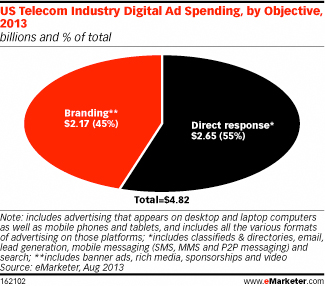US Telecom Industry nears $5 Billion in Ad Spending
November 25, 2013
![]() As the market for broadband connectivity, wireline and wireless services becomes saturated, US telecom carriers, cable TV operators and internet service providers are using online and mobile channels to promote new technology, faster networks, superior video quality and more profitable “bundled” services and data pricing plans, according to a new eMarketer report, “The US Telecom Industry 2013: Digital Ad Spending Forecast and Key Trends.”
As the market for broadband connectivity, wireline and wireless services becomes saturated, US telecom carriers, cable TV operators and internet service providers are using online and mobile channels to promote new technology, faster networks, superior video quality and more profitable “bundled” services and data pricing plans, according to a new eMarketer report, “The US Telecom Industry 2013: Digital Ad Spending Forecast and Key Trends.”
 These companies—many of which are among the country’s largest and most innovative advertisers—are also experimenting with new ad formats and content sponsorships aimed at strengthening brand loyalty while retaining and upselling existing customers.
These companies—many of which are among the country’s largest and most innovative advertisers—are also experimenting with new ad formats and content sponsorships aimed at strengthening brand loyalty while retaining and upselling existing customers.
eMarketer expects such efforts will help push US telecom industry digital ad spending to $4.82 billion in 2013, and up to $6.69 billion by 2017.
 This year, eMarketer has taken a deeper dive into US paid digital spending to determine how much marketers in vertical industries are investing in ads primarily aimed at obtaining sales or leads compared with those focused on driving favorable opinion about a brand. Because telecom operators sell and deliver their own products and services, they have been aggressive with both direct response and branding campaigns. As a result, spending objectives are more evenly split for this industry than in others.
This year, eMarketer has taken a deeper dive into US paid digital spending to determine how much marketers in vertical industries are investing in ads primarily aimed at obtaining sales or leads compared with those focused on driving favorable opinion about a brand. Because telecom operators sell and deliver their own products and services, they have been aggressive with both direct response and branding campaigns. As a result, spending objectives are more evenly split for this industry than in others.
eMarketer estimates the US telecom industry will spend 55%, or $2.65 billion, on direct-response advertising in 2013. These formats include online and mobile paid search, classifieds, online directories and paid ads embedded in email messages.
The industry will spend nearly as much, 45%, or about $2.17 billion, on branding-related buys. These include online and mobile banner ads, rich media, online video, paid social placements, in-game ads, content sponsorships and native advertising. As industry marketers place more focus on customer retention and loyalty, investments in these formats are expected to grow more quickly than search during the forecast period.
Courtesy of eMarketer





























